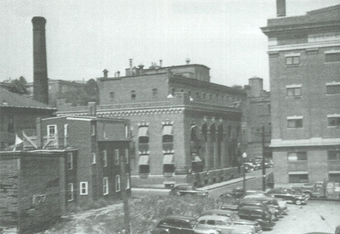Highland Spring Brewery Bottling and Storage Buildings facts for kids
Quick facts for kids |
|
|
Highland Spring Brewery Bottling and Storage Buildings
|
|
 |
|
| Location | 154-166 Terrace St, Boston, Massachusetts |
|---|---|
| Area | less than one acre |
| Built | 1892 |
| Architectural style | Colonial Revival, Romanesque |
| NRHP reference No. | 10000300 |
| Added to NRHP | May 28, 2010 |
The Highland Spring Brewery Bottling and Storage Buildings are a group of old industrial buildings. They are located in the Mission Hill area of Boston, Massachusetts. These buildings have a long and interesting history. They were first built starting in 1892. Over the years, they have been used for many different purposes. Today, these historic buildings have been turned into homes.
Contents
A Look at the Buildings' History
The Highland Spring Brewery Bottling and Storage Buildings are made of brick. They are found at 154-166 Terrace Street in Boston. The main building was built in 1892. It has four stories and was used by the Highland Spring Brewery. In 1912, another building was added. This one had five stories.
The Highland Spring Brewery
The Highland Spring Brewery started in 1867. It was founded by two immigrants, one from Ireland and one from Germany. The brewery became very successful. It made different kinds of beer. Its products became well-known across the country.
The brewery had two main buildings. One was for making the beer. The other was for bottling and storage. These two buildings were connected by a tunnel. This helped them move things easily.
The Time of Prohibition
The brewery stopped making beer in 1920. This was because of a time called Prohibition. During Prohibition, it was against the law to make or sell alcohol in the United States.
After Prohibition ended in 1933, a new brewery opened. It was called the Croft Brewery. It used the 1892 building. The storage building had been sold to another company.
Other Businesses in the Buildings
The Croft Brewery was later bought by the Narragansett Brewing Company in 1952. They only stayed for one year. Then, in 1958, a company called R & S Pickle Works bought the 1892 building. They made pickles there until the mid-1980s. The building was empty for many years after that.
The 1912 building was bought by the Oliver Ditson Company in 1925. This company was famous for publishing sheet music. They printed music there until 1931. Then, another company, the Theodore Presser Company, took over. They continued printing music until the 1950s. Later, this building was used as a printing plant again. It was also used as a warehouse for a while.
New Life for Old Buildings
Since 2008, both buildings have been given a new purpose. They have been fixed up and turned into affordable homes. This means they now provide places for people to live.
The buildings were officially recognized as important historical places. They were added to the National Register of Historic Places on May 28, 2010.
Images for kids




